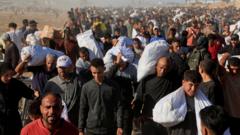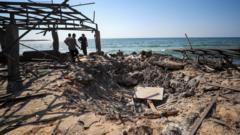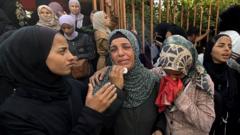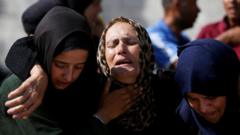Impact Investment – Blended Finance Refugee Fund – Hybrid Investment Model to Enable Refugees in Jordan
- “1 per cent of the world’s population have fled their homes“
- The number of people displaced by conflict – refugees, asylum seekers or those displaced internally – is estimated at 80 million!
- Almost half of the worldwide refugees come from Syria, Afghanistan and South Sudan; with Syria the top source country
Although they are outside main media focus, the numbers of refugees are still increasing and have not receded because of the Corona crisis.
While many benefactors are trying to help with traditional aid, there are not many commercial financing instruments available aiming at refugee empowerment. Herein we explore a Blended Finance Refugee Fund for a Hybrid Investment Model to Enable Refugees in Jordan:
JORDAN CONTEXT
Let’s start by looking at the tragic backdrop:

- The war in Syria has raged on for six(+) years, causing a staggering 12 million people to flee for their lives – the largest refugee crisis of our time
- About half are displaced inside the country and the other half fled to nearby countries in search of safety
- Jordan hosts 1.3 million Syrian refugees2. Similar number is living in Turkey and Lebanon3
Focus on Syrians in Jordan
- At 12%, Jordan hosts the second largest number of refugees relative to the size of its population with 120 refugees for every 1,000 inhabitants4
- With no immediate return on the horizon, humanitarian assistance diminishing and livelihood options limited, the challenge is to sustain levels of funding needed to cover the basic needs of vulnerable refugees and at the same time broaden the options for Syrian refugees to pursue a dignified and productive future in the region
Negative effects
- The sudden influx of Syrian refugees had a significant impact on the Jordanian labor market
- There are serious pressures on job opportunities, wage levels, working conditions and access to work, for Jordanians as well as for refugees & migrant workers
- This is of particular concern in the northern governorates where the share of Syrian refugees and the pressure on the labor market is greatest5
- Hosting a large number of refugees increases government expenses across the budget
- The direct and indirect impact of hosting Syrian refugees during main conflict 20111-17 has cost Jordan $7.9 billion6
- One of the most cited figures is by the Central Bank of Jordan, which estimates that the Syrian crisis (not only refugee crisis) has reduced Jordan’s GDP growth by 2% in the midst of the crisis7
Some positives
- Syrian presence is already contributing to domestic production of goods and services as they increase consumer demand
- Wages earned by Syrian refugees and their savings are spent / injected in the Jordanian economy
- In 2012 the Jordan Investment Board registered 114 million dinars of Syrian investment in the Kingdom, up from 3m dinars the previous year8
Balance
- Unless Syrian refugees are offered opportunities to preserve their livelihoods, they will threaten Jordan’s social & political stability9
- Further vulnerability of Syrian refugees means a reduction in future capacities for their possible return to Syria & in their ability to participate in Syrian reconstruction
- A blended finance refugee fund or similar
Jordan is a good host

Emigration waves (150 years)
Over the years, Jordan has been considered a home for millions of people fleeing for a better & safer place
- Early records go back to 1868 when the first Charkese arrived to Jordan, followed by the Chechens due to the Caucasian war
- Skilled workers from Syria came to Amman for a better opportunity in 1908
- The Palestinians arrived in three different waves starting from 1948, 1967 and 1991 when they arrived from Kuwait due to the Gulf War
- Almost a million Iraqis came to Jordan in 2003 after U.S war and finally the Syrian crisis in 2011
- The Majority of them became part of the Jordanian community and contributed in the development of the economy with their different skills sets
Refugee distribution
96.9% of the Syrian refugees live in the Central and Northern Governorates11
Proximity to Syria

Regional spread

Unregistered refugees
According to the Jordanian Government, there are 606,000 unregistered Syrians in Jordan12
- About a half of the total 1.3 million Syrians in Jordan12
- According to some experts, the unregistered number is lower (up to 150 thousand) with the difference attributed to double registrations from some refugees to get more cash allowance
- There are numerous reasons why so many Syrian refugees are unregistered in Jordan:
- Fear of being forced to return to Syria if they come forward
- Refugees who are in need of protection and/or assistance but do not want to register with UNHCR
- Some refugees also appear to be fearful of sharing any information with the authorities
- Refugees have cited the registration interview questions about religious/political/social affiliations or military history as a reason why they do not want to register
Demographics on the registered Syrian refugees2
- 7% are living outside camps
- Female / male ratio about the same
- About half are under 17 years old
- 45% of the refugees are between 18-59 years
- Only 4% of the refugees are above 60 years
- The unemployment rate for the Syrian refugees is 61%
- The vast majority of registered refugees are living outside of the refugee camps
- 86% of Syrian refugee individuals are living below the Jordanian poverty line

Distribution of skills
The skills data was compiled based on interviews with experts in the Syrian affairs
- The skills & opportunities needed vary from one region to another, while in the north there is more focus on the agricultural skills and craft trade, we see that in the central governorates there is more focus on wholesale & trade, because of increasing numbers of consumers in the central region in comparison with the north
Syrians outside camps who would become refugees in Jordan (Mar’11), worked as5:
- Skilled agricultural workers
- Construction
- Wholesale and retail workers
- Manufacturing
- Transportation
- Craft related trades
- Professional technicians
Syrians outside camps who became refugees in Jordan (February 2014) worked as5:
- Craft related trades
- Professional technicians
- Service and sales workers
- Associate professional technicians
- Plant and machine operators
- Clerical support workers
- Repair and service industry
- Accommodation and food
- The difference in skill-sets of Syrians outside camps who became refugees in Jordan between 2011 and 2014 was due to the change in the work opportunities and the changes in government regulations

Unemployment & vulnerability
The unemployment rate among the Syrian refugees is 61%
- Unemployment and activity rates of Syrian women are particularly low at 83%
- Cultural factors combined with the high share of small children that need adult care can explain such numbers
- The Jordanian government has offered a rough estimate that perhaps 30,000 Syrian children are working14
- 86% of Syrian refugees are living below the Jordanian poverty line of 68 JOD per capita per month, and are therefore rated as being highly or severely vulnerable15
- This corresponds with 68% of Syrian households
- Further 10% of Syrian refugees are living below the abject poverty line of less than 28 JOD
- In general highly & severely vulnerable families are larger by size
- There are differences in the levels of vulnerability across the four geographical regions15
- 64% of cases in the Northern region as highly vulnerable or above, versus only 30% in the Central region
- The Central region includes Amman and Zarqa’ where the majority of least vulnerable families live, more rural areas of the central region including Madaba & Balqa have higher levels of vulnerability

Impact objectives
Suggested impact areas for a Blended Finance Refugee Fund, all of which are aligned with the UN Sustainable Development Goals (SDGs or Global Goals), with some impact areas more obvious than others. Impact measurement will be an integrated part of the strategy built into the investment process
- Primary impact: direct refugee finance will by definition have a strong social impact component
- decent work & economic growth; reduced inequalities
- Secondary impact: direct refugee finance will by default generate improved living conditions, but so will financing those businesses that specifically cater to refugee needs
- good health & wellbeing; quality education; clean water & sanitation; affordable & clean energy; no poverty; zero hunger; gender equality
- Tertiary impact: targeted SME finance & entrepreneurial development will be additional to the local ecosystem
- industry, innovation & infrastructure; sustainable cities & communities; responsible consumption & production; peace, justice & strong institutions
- Quaternary impact: collaboration between the private & public sector to contribute to integration & self-reliance
- partnership for goals
Impact monitoring
The Syrian crisis increased the pressure exerted on the country’s infrastructure, which creates a challenge along the path of the UNDP’s SDGs implementation
- Displaced people and SDGs are closely intertwined; each of the 17 goals need refugees & migrants to be integrated in their implementation -> here are the main SDGs a Blended Finance Refugee Fund would contribute to address:

Challenge & opportunities
With the continuation of the crisis in Syria there are few prospects for early repatriation of refugees
- It is increasingly difficult to mobilise sufficient domestic & external humanitarian assistance to be able to support Syrian refugees in Jordan; nor does humanitarian assistance cover family’s basic needs
- Host governments (including Jordan), donors and multilateral organisations are increasingly coming to the realisation that a protracted refugee presence requires new & innovative ways to gradually promote self-reliance and livelihoods of refugee communities, while maximising their contribution to national & local development priorities
- Key market needs (opportunities) and SDGs to address refugee challenges:
Primary impact
Job creation
From 2011 to 2014, no one sector in Jordan created more than 60k jobs19
- Construction & garment sectors show best promise for growth, yet there will need to be a careful match between the types of jobs / working conditions created, and refugee & Jordanian skills / incentives, in order for growth to have a positive impact on the vulnerable socioeconomic conditions8
- Jordan Compact initiative (see below) aims to provide 200k jobs for refugees in exchange for preferential access to the European market as well as access to conditional financing from the World Bank
- By 2017: 9 firms applied to export to the European market; 37k work permits had been issued to refugees; 4% of the permits going to women18
Opportunity – Economic Empowerment
Acceleration & investment in the creation & growth of SMEs led by Syrian refugees, or those led by Jordanians but focusing on employing Syrian refugees
- Ease the work permit procedures, which will also decrease grey economies
- Encourage the employment of Syrian refugees in needed industries
- Attract Syrian investments & know-how transfer in needed industries
- Address skills for out of school youth as well as adults, to improve self-reliance
- Facilitate the establishment of micro & small businesses as prerequisite for empowerment
Legal aspects
- Syrians can work without any approval needed in open sectors (the approval is only needed for new venture creation but not employment)
- Based on the demand for & the availability of qualified Jordanian labor, the Ministry of Labor determines which occupations are open to foreign labor
- The government is opening some of the closed sectors for Syrians after applying a qualification process
- The majority of occupations that are open to foreign labourers (including Syrians) are unskilled/semiskilled/technical, and are concentrated in agriculture, construction, manufacturing & service sectors
- In 2016, the EU signed a deal with Jordan to simplify the rules of origin for products manufactured in special economic zones. Companies operating from these zones will be able to export products that include over 70 percent of non-local production inputs to European markets tariff-free. These companies must employ 15% of their labor from Syrian refugees. This rate will increase to 25 percent in the deal’s third year. Once 200,000 Syrian refugees are employed, the deal’s relaxed rules will further extend to other product groups across Jordan
As of January 2017, there were 17 professions closed to foreign workers in Jordan, including:
- Administrative & accounting
- Clerical professions
- Telecommunication jobs
- Jobs in sales
- Most technical & mechanical professions
- Engineering
- Education
- Professions in hospitality
- Health care sector
According to the 2016 regulations for foreign workers in small enterprises, the following jobs were restricted unless they will provide jobs 10 jobs in 3 months from registration:
- Blacksmith, metal turning & forming
- Carpentry
- Embroidery
- Jewel works
- Craftworks
- Dry cleaning & clothes dyeing
- Hair cutting & padding
- Jobs in sweets & ice cream stores
Work permits:
- With almost 330k Syrian refugees of working age 15, only 14% have been issued work permits20
- Some work without permits as day labour, freelancers, seasonal or could not get permits for chosen professions
Business setup
Requirements to register a company are becoming less stringent: these need to be differentiated from job creation, although in the case of Syrian refugee micro-enterprise creation, they will often go hand in hand
- Special Economic Zones (SEZ) were created where companies can access trade concessions in exchange for offering jobs to Syrians
- the SEZ program is part of the $1.7 billion Jordan Compact, where a wide-ranging deal of loans & pledges from the international community is exchanged for Jordan opening up its labor market to refugees
- organisations operating from the SEZs will be expected to employ 15% Syrians within their workforce, and will access tariff-free trade in the European market in exchange16
- More generally, two channels are open to Syrians who want to open business in Jordan:
Channel 1
Jordan Investment Commission (pre-Syrian crises)
According to the JIC and the Investment Law for non-Jordanians (year 2014): the rules for company registration are the same for both the Jordanians and Syrians, with the following notes:
- The Syrian citizen will require an approval from the Jordanian Ministry of Internal Affairs
- A Syrian can open a company for any purpose including but not limited to industry, agriculture & technology
- A Syrian can create but owns up to 49% of any company created for purpose of but not limited to: trading, retailing, construction, food services & consulting
- The minimum amount of investment is $70,000
Channel 2
Ministry of Industry (post-Syrian crises)
The Steps to register a company by a Syrian:
- Buying a formal application form from the Companies Fund for $15 and filling it by would be owners
- Receiving the approval and selecting a trade name
- Giving the partners a document for the bank to deposit 50% of the capital Value.
- Paying the registration fees with a value depending on the capital value, not less than 465JOD
- Preparing the initiating report and assigning company delegates for signing
- Hiring a financial auditor for the company
Secondary impact(s)
While direct refugee finance will by definition have a strong social impact on job creation & economic growth, but there is also a whole set of other opportunities to address challenges by financing those businesses that amongst other also specifically cater to refugee needs (good health & wellbeing; quality education; clean water & sanitation; affordable & clean energy; no poverty; zero hunger; gender equality)
Health
- The Syrian crisis has resulted in increased prevalence of diseases
- The 2012 decree that granted Syrians access to national healthcare services has strained infrastructure and increased the cost of national system: shortage of health staff, drugs, medicines, equipment & beds
- Medical expenses related to Syrian refugees is estimated at USD 220 million for 2015 Syrian refugees in Jordan have the highest rates of severe emotional disturbances compared to those in Lebanon or Turkey, with limited resources for diagnoses & treatment
- Challenge: strain on health infrastructure, government budget & quality of service
- Opportunity: encourage specialized & generalist clinics or diagnosis centers
Education
- The Syrian crisis has had a profound impact on the education sector
- Public schooling fully granted to Syrian refugees free of tuition which caused overcrowding in classes, double shifts for teachers & increased costs
- The Syrian students are treated at the public and private schools the same way as the Jordanian student (41% of schools are considered overcrowded)
- 100,000 Syrian students are enrolled in Jordanian schools resulted in estimated cost increase of $280 million
- Unregistered Syrian children or those without documents are attending unofficial schools, with the government trying to resolve this
- Challenge: strain on health infrastructure, government budget & quality of service
- Opportunity: support for children day care centers & adult vocational centers
Infrastructure
- With the majority of refugees living in urban communities, they are competing with Jordanians for access to public services and infrastructure
- Solid waste management which exceeds the collection municipality capacities
- Water distribution networks & sewage systems are also becoming inadequate with urgent maintenance / upgrading needs / capacities
- The road networks are in serious need for maintenance, especially those that are immediately affected by the Za’atari camp-related traffic
- Street lightening also needs maintenance & expansion to cover new geographical areas
- Challenge: urban community infrastructure strain higher than rural
- Opportunity: PPP initiatives for improved municipal financing attractiveness
Basic needs
- Support & strengthen the link between emergency assistance and durable solutions in responding to the humanitarian crisis
- 92% of the individuals are identified as high or severely vulnerable for basic needs15
- There were no individuals identified as having low rates of vulnerability
- Most aid comes in form of food vouchers or cash assistance
- The most common source for food is the WFP vouchers
- The cash assistance is used to buy food items with needs estimated at 42% women, 15% elderly & 6% disabled17
- Other than food, aid is used for clothing, shoes, women hygiene kits & elderly people needs
- Challenge: linking aid with durable solutions in responding to the crisis
- Opportunity: nurturing sustainable agribusiness models & employing vulnerable groups
Women & children
- Over 75% of the Syrian refugees are women & children, and they face additional unique challenges3
- Women: Unemployment ± Child marriage ± Violence ± Special health needs
- Children: Child labor ± Access to education ± Child abuse ± Psychological distress
- Empowerment of women has proven to have great spillover effects on many of the challenges…
- Targeting businesses across the themes should also be given priority if they explicitly cater to vulnerable groups
- Challenge: three-quarters of Syrian refugees are women & children
- Opportunity: women training centres & incentives for employment
IMPACT MARKET IN JORDAN
Aid & assistance
Strong activity, commitments & coordination efforts
- In responding to the refugee crisis, the Jordanian government has been supported by the UN(HCR) and assisted by the international community
- Since the beginning of the crisis, a number of annual appeals were launched to ensure that Syrian refugees could be sheltered and fed and supported with essential protection services
- The appeals have also called for assistance to support vulnerable Jordanians affected by the crisis and to foster the resilience of host communities and national institutions
- The Jordan Response Platform for the Syrian Crisis (JRPSC) was established to coordinate, guide and provide oversight to the preparation, implementation and monitoring of comprehensive humanitarian and resilience-based response to the Syria crisis
- JRPSC brings together government representatives, donors and UN agencies under one planning and coordination framework to ensure an effective, nationally-owned and coordinated response to the multi-facetted challenges faced by the country as a result of the Syria crisis
- It brings together humanitarian and development partners from government, UN agencies and NGOs, to provide a forum for sectorial strategic decision-making to develop and implement, under the government’s leadership and guidance, a coherent refugee and sector-specific response to the impact of the Syrian crisis
Jordan compact initiative


A particularly valuable initiative by the EC because it gets concrete job creation / business setup commitments by the Jordanian government
- The Jordan Compact presented at-the 2016 London conference sets out a series of major commitments aimed at improving the resilience of refugee and host communities, focusing mainly on livelihoods & education2
- The government of Jordan will undertake the necessary administrative changes to allow Syrian refugees to apply for work permits both inside and outside of the zones, and provide work permits for up to 200,000 Syrian refugees
- EU will simplify its Rules of Origin, improving access to the EU market
- The Government of Jordan intends, as a pilot, to designate five development zones and provide these with maximum incentives under the new investment law
- Syrian refugees will be allowed to formalize their existing businesses and to set up new, tax-generating businesses
- The Government of Jordan will provide for a specific percentage of Syrian involvement in municipal works through private sector employment on a contract basis
However, the progress towards implementing the Jordan Compact has been slow & uneven – some cited reasons being2, 21:
- New type of partnership not adjusted to ground realities & constraints
- Specific economic, social and structural challenges in the Jordanian context
- Potential weaknesses in the Compact’s design and management
- Issues in Work permits and lack access to formal financial and banking services

Opportunity
To learn & improve on actual experiences of refugees, including work permit & business formalisation processes, and vulnerabilities women face in search of safe & decent work
Many active participants
Examples of corporate involvement

Generalist aid
Plenty of the activities focused mainly on relief & basic needs, but little on economic development & direct empowerment, targeting SMEs creation, development and growth

Women & children

Health

Opportunity
All the listed active organisations in Jordan (and more that have been unintentionally missed) which seek more direct empowerment of refugees in improving their livelihoods are also potential cooperating partners to a hybrid financing model project…
Private sector involvement
From charitable to strategic
Companies can accelerate solutions to the refugee crisis through philanthropy & grants (CSR), but also through social impact investment supporting refugee social enterprises to achieving both community and commercial returns
- UN Global Compact, UNHCR & others are calling on companies to take actions to diminish suffering of people forced to flee conflicts
- Companies can adapt their business model to combine social & business benefits while leveraging their core capabilities to achieve social impact, a Shared Value Approach in addition to philanthropy
- Scaling the resources of the private sector by linking Jordan & Syrian communities development objectives with companies core business practices can have a significant social impact
- Companies are vital partners in achieving the UN Sustainable Development Goals (SDGs)
Business strategy
Each business case is specific depending on the company’ s social investment objectives
- From new market development incentives, to fostering innovation, to championing entrepreneurs & skill-based employee volunteering, to managing risks & building relationships with the region, to enhancing reputation, contribution & responsibility
- ‘Innovative financing mechanism approach’: companies taking equity stake in social ventures or developing social venture funds
- ‘Supply chain approach’: procurement from social ventures (e.g. Ikea is partnering with local NGOs to start a line of textiles & rugs made by refugees mostly women, or Starbuck is hiring refugees)
- ‘Last mile approach’: companies gaining insight on targeted BOP markets through partnering with social ventures, to customise their products (e.g. Google, Microsoft & TripAdvisor developed an information hub for refugees, LinkedIn a welcome talent app, and AirBnB an open home app)
- ‘Incubation approach’: contributing to business accelerators to grow social ventures
- ‘Social innovation approach’: Concentrating on tech social ventures and harvesting social venture ideas
- ‘Advocacy approach’: Selecting social ventures as advocacy relay on targeted issues e.g. Nestle’s advocacy for facilitating refugees’ integration, Ben & Jerry’s Together for refugees campaign
SME financing & entrepreneurial development / positioning
It is quite clear that there is a significant active participation in the efforts to aid & assist Syrian refugees in Jordan, but there are not many targeting SME creation, development & growth
Three examples that are scratching the surface:
- EBRD supported Microfund for Women ($2mil loans)
- Google supported Mercy Corps program ($3mil)
- USAID supported Endeavor / ATH Beyond Capital program ($10mil)
More private sector activity is required, helped by the various initiatives & commitments by the multinationals & the Jordanian government
For a Blended Finance Refugee Fund we are now looking for cooperating partner organisations (donors, NGOs, companies) to help define further the (unrestricted) target sectors & the (potential) deal pipeline
- Joint approach to Jordanian government agencies
- Open policy dialogue with other vested participants
- Financing / executing further investigation requirements
- Getting key stakeholder commitments & finalising the fund structuring
- Raising funds internationally from both donors & (quasi) commercials for a blended or hybrid financing model…
Refugee empowerment dominates this Vitrine Theme, with the commercial financing component being the key for a Blended Finance Refugee Fund (an impact investment fund). If you would like to know more about the actual opportunity at hand- you can write us with a genuine wish to discuss this further, and we will send you the password to the second & final section of the hybrid refugee finance model: It includes the experts involved, their blended financing approach, the potential fund size, strategy & the value added requirements…
1: UNHCR website data.
2: In search of Work, IRC, February 2017
3: External Statistical Report on UNHCR Registered Syrians as of 15 March 2017, UNHCR information sharing portal for Syria regional refugee response.
4: UNHCR Operational Update, April 2017
5: ILO and Fafo Impact of Syrian Refugees on the Jordanian Labour Market, 2015, statistical appendices for Jordanian host communities and non-camp Syrian refugees.
6: According to a statement made by the Minister of Planning and International Cooperation during the third International Conference on Financing for Development.
7: Wazani, K. (2014) ” The Socio-Economic Implications of Syrian Refugees on Jordan: A Cost-Benefit Framework” Konrad Adenauer Stiftung.
8: A bittersweet opportunity, N.W, The Economist, Aug 2013.
9: UNHCR, Finding a future, November 2015
11: Jordan Response Platform for the Syrian Crisis – Website.
12: Government of Jordan, “2015 Jordan Population and Housing Census”, February 2016.
13: Data are taken from an unpublished 2016 Statistical Review of the ILO’s Regional Office for the Arab States on Syrian refugees in the Jordanian labour market. The ILO derived the data on Jordanians from the Jordan’s Department of Statistics labour force survey, second round 2015, and the data on Syrian refugees from the UNHCR and Stave and Hillesund (2015).
14: UNICEF (2013) Syrian Refugee Children in Jordan: Assessments desk review on the situation of Syrian refugee children living in Jordan
15: Jordan Refugee Response – Vulnerability Assessment Framework Baseline Survey May 2015.
16: The Jordan Compact.
17: Data obtained for UNHCR –VAF assessments as of March 2017.
18: Project Management Unit, Ministry of Planning and Cooperation, Government of Jordan. January 15th , 2017. “Presentation on Livelihoods for the HPDG.”
19: Data from Jordan Department of Statistics. Analysis performed by McKinsey & Company for the International Rescue Committee in 2016.
20: Impact of the influx of Syrian refugees on the Jordanian labour market : findings from the governorates of Amman, Irbid and Magraq/ Svein Erik Stave and Solveig Hillesund ; International Labour Office ; Fafo Institute for Applied International Studies. – Geneva: ILO,2015
21: Walk the Talk – A visual product for the Jordan Compact, September 2017, INGO

Photo:M.Umarova
Theme Related Tracker
Gaza watch – United Nations Economic and Social Commission for Western Asia – ESCWA



























